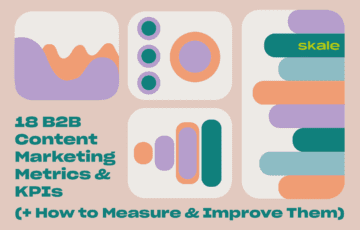
13 B2B Content Marketing Agencies and Services to Generate Revenue in 2024
These B2B content marketing agencies can create strategies and content that generates serious revenue for your business.


Our SaaS SEO experts will partner with your team to exceed your revenue goals.
Schedule a callSo, first things first. What is a SaaS content audit and why is it important?
It’s pretty much what it says on the tin: a systematic evaluation of your SaaS content. Its goal is to gather the data necessary to provide valuable insights about how to move forward.
A full content audit for SaaS businesses is a chance to step back and analyze the quality and results of your existing website in order to determine your future content marketing strategy.
Think of it as a type of review: an essential step to move forward and grow, indicating what’s working well and what isn’t.
In this guide, we’re going to walk you through the ins and outs of a SaaS SEO content audit: from where to why to how—we’ll leave no stone unturned.
Let’s get started.
From blog posts to landing pages, a SaaS content audit will help you develop up-to-date, quality content for your target audience. It will trawl your site’s content to identify gaps, outdated content, and duplicate content. It may be an undeniably time-consuming process, but it offers exceptional ROI in terms of optimizing content and increasing site visitors.
Creating content—especially effective, engaging content—is no mean feat, and it certainly helps to look at the bigger picture every now and then. From meta descriptions to keyword research, a SaaS content audit is designed to boost a site’s search engine optimization (SEO) in order to drive up organic traffic and increase those conversions.
Let’s look at some of the key benefits of conducting a SaaS content audit.

We’ve done the research and listed the top UK marketing agencies who will save your team time and budget while generating maximum ROI.
Read the listCarrying out a content audit every 3-6 months is a great way to make sure your content is consistently fresh, exciting, and engaging with your target audience. Auditing your content every 3-6 months gives you time to respond and adapt to shifts in users’ behavior and market trends. It’s a step-by-step process that can take time, so it’s worth scheduling some time to prepare for it.
“The frequency of content audits for SaaS businesses depends on various factors such as the size of the content library, frequency of content creation, and industry dynamics. Regular monitoring of content performance and user feedback can help identify the need for more frequent audits and updates.”
–Nathan Clark, Co-Founder at Gate2Ai
Here are some questions to ask yourself before a content audit:
Remember, it’s not necessarily about how long the content audit itself takes, but the actions you take based on the data it yields. So, what might come out of your content audit?
Let’s go through the stages involved in a content audit, step by step.
First things first. In order to carry out a content inventory it’s crucial to know who your site is aimed at. This will ensure you maintain a consistent voice and tone throughout your entire website.
It’ll also ensure that you collect data that are specific to your target audience, data that will define your future content marketing efforts. Remember that your website visitors will be at different stages of the marketing funnel, so it’s important to map out your customer journey and know at which stage each piece of content is aimed.
Like Abhishek Shah, Founder at Testlify says:
“Start by clarifying the goals of your content audit. Are you aiming to improve lead generation, increase customer retention, or enhance brand awareness? Defining your objectives helps align the audit process with your overall business strategy.”
Clear priorities are key. Whatever your goals are, it’s essential to take the time to define them clearly. You need to know what you’re hoping to gain from your content audit: all the factors you need to inform your decisions. Ask yourself these questions:
This is the first step of collecting and categorizing your content. You’ll need to take a content inventory of everything on your website, including blog posts, articles, videos, white papers, how-to guides, interactive quizzes, and everything.
There are multiple content audit tools available (such as Google Search Console, Screaming Frog, and Semrush) to help you compile a list of all the URLs on your website. Once you’ve gathered your list, you’ll need to audit each one systematically, determining whether it needs to be deleted, updated, or redirected. This is your chance to root out any broken links or dysfunctional pages.
Whether it’s repurposing old content that isn’t performing well, adding new sections, or deleting an entire webpage, each page will need to be categorized to implement the corresponding changes. The data you gather will inform you about whether to remove, replace or redirect content.
Now you’ve completed the first stage of your audit, you’ll need to take a deep dive into exactly how it’s performing. Ideally, you’ll want tangible KPIs that indicate the health and performance quality of your website content. Engagement metrics are central to successful SaaS content audits: they give an idea of how valuable your content is to those who are reading it.
Here are some examples of SaaS SEO metrics to watch for (remember, what’s acceptable for you will depend on your specific area):
A spreadsheet containing all the metrics and important information about each piece of content is a great way to keep things simple. Like Sudhir Khatwani, Founder at The Money Mongers, says:
“One fundamental step I always advocate for is the comprehensive cataloging of content assets. This process involves documenting every piece of content—blog articles, eBooks, videos, web pages, etc., in a structured spreadsheet. SEO tools like Screaming Frog SEO Spider can help automate this task, and Google Analytics proves invaluable for collating performance metrics.
Next, a non-negotiable step is content quality and performance assessment. Review each piece of content for its relevance, accuracy, and engagement metrics—traffic, shares, conversion rates, and so on. This analysis will illuminate what’s resonating with your audience, what needs fine-tuning, and what’s outdated.
Lastly, I always insist on a content gap analysis. By juxtaposing your content with your competitors, you can spot missing content types or themes in your current strategy and discover opportunities for novel content creation.”
Using the data from your content audits, you’ll need to update your current content marketing strategy. A helpful tip is to develop a content calendar that addresses your findings, by filling the gaps and finding new directions to satisfy the search engines.
The final stage goes beyond the content audit itself: you’ll need to keep a close eye on your metrics throughout the year, to monitor the results of your content audit, and to keep reaching your goals. It’s important to keep updating your ideal metrics as your company grows and your web page attracts more visitors over time.
Additionally, monitoring your metrics will allow you to optimize the right content. Failing to update outdated content on your website can make your company seem outdated and not a leading authority in your industry. Typically, updating and optimizing the content is enough to bring it back to life for visitors and search engines. However, if the content is irrelevant or underperforming, deleting it altogether can enhance the overall quality of your content library and potentially offer opportunities for repurposing or republishing.
There are multiple ways to do a successful content audit for SaaS companies, but here are some top tips to bear in mind while carrying out content analysis.
And always remember what Daniel Chabert, CEO & Founder at PurpleFire, says:
“Unique to SaaS, understanding the user journey and aligning content accordingly is essential. SaaS products typically have longer buyer journeys; hence, content audits should carefully examine if material contributes to the evolution of a prospect into a customer. Furthermore, support and technical content should not be neglected as SaaS customers often seek help and instructions post-purchase.
Remember, even the most brilliant SaaS solution will struggle to sell if it isn’t backed by equally brilliant content. A thorough, well-conducted content audit is a cornerstone of achieving that synergy.”
It’s all very well putting in the hours into optimizing your content marketing strategy, but at the end of the day it has to be the right content—the content that will generate the most impact for your business—that you’re putting first.
A successful content audit will help you establish what content is working for you, allowing you to refine your efforts and ensure that the work you’re doing is really paying off. Every single page on your website needs to be geared towards attracting and retaining prospective customers, and a content audit will help you make sure this is the case.
A strong SEO strategy is becoming ever more important for SaaS businesses around the world. It’s essential to keep your finger on the pulse, measuring SaaS content performance and continuously improving existing content.
Working with a dedicated SEO content marketing agency with years of experience in the sector can help improve your chances of developing a highly effective, high-ROI website that generates the leads you’re looking for. Skale has helped multiple industry-leading SaaS businesses to make their entire content marketing processes easier for the user. It’s a crucial step in any marketing strategy: now’s the time to get started.

Let Skale’s SEO team identify opportunities to fill your ARR gap with a content audit.
See Skale’s ServicesLearn more about
B2B CONTENT MARKETING

13 B2B Content Marketing Agencies and Services to Generate Revenue in 2024
These B2B content marketing agencies can create strategies and content that generates serious revenue for your business.
![Ignite Engagement: 9 B2B Content Marketing Ideas [with Expert Insights]](png/skale-december-4-360x230.png)
Ignite Engagement: 9 B2B Content Marketing Ideas [with Expert Insights]

18 B2B Content Marketing Metrics & KPIs (+ How to Measure & Improve Them)
We look at which B2B content marketing metrics you should measure, how to measure them, and what to do when you need to improve your content strategy.